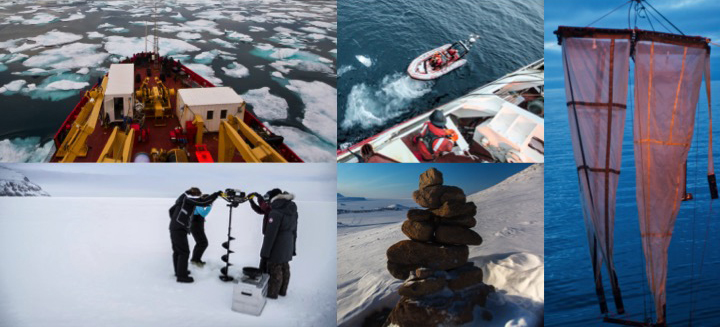The Green Edge Project is an elaborated study of the Arctic marine ecosystem under phytoplankton spring bloom (PSB) conditions
In Green Edge, we focus on primary productivity and on the fate of organic matter produced by phytoplankton during the most productive period of the year: spring. Green Edge is also partly motivated by the recent discovery that phytoplankton blooms may occur more extensively and more often under the ice-pack.
Green Edge contributes to the major societal challenge of efficient resource management and adaptation to climate change, through a better understanding and anticipation of environmental change. We address significant knowledge gaps in Arctic marine biogeochemical cycles and the food web, and their linkages with local human populations.
Green Edge is a large multidisciplinary project that brings together concepts extending from oceanography to whole-ecosystems, to impact on society. The scientific program is partitioned into a total of 6 work packages (WP)
- Coordination and communication
- Spring bloom dynamics
- Carbon transfer through the food web and towards the bottom
- Contribution of spring bloom to primary production at pan-Arctic scale, and current trends
- Spring bloom in the past
- Spring bloom in the future
- Local knowledge about environment and harvested food
Labs involved in Green Edge Project
The Green Edge consortium includes cutting-edge expertise in all aspects of the project (processes, modelling and remote sensing). In addition, because the Arctic marine environment is peculiar, several Arctic specialists are involved.
CANADA
- Takuvik (UMI 3376; Université Laval/Canada and CNRS/France)
- Institut des Sciences de la Mer (ISMER, Rimouski)
- Département de biologie, chimie et géographie (UQAR, Rimouski)
- Centre de recherche en géochimie et géodynamique (GEOTOP, Université de Montréal)
- University of Manitoba, Arctic Biogeochemical Laboratory (Winnipeg, MB)
- University of Calgary, Department of Geography (Calgary, AB)
- Department of Fisheries and Oceans Canada (DFO), Centre for Ocean Model Development and Application (COMDA) (St. John’s NF)
- Canadian Museum of Nature
- Centre de recherche du CHU de Québec (CHU de Québec)
- Centre interuniversitaire d’etudes et de recherche autochtones (CIERA)
FRANCE
- Laboratoire d’Océanographie de Villefranche (LOV, UMR 7093)
- Adaptation and Diversity in the Marine Environment, Station Biologique de Roscoff (SBR, UMR 7144)
- Laboratoire d’Océanographie MICrobienne (LOMIC, UMR 7621)
- Laboratoire d’Océanographie et du Climat: Expérimentation et Approches Numériques (LOCEAN, UMR 7159)
- Laboratoire des sciences de l’Environnement Marin (LEMAR, UMR 6539)
- LIttoral ENvironnement et Sociétés (LIENs, UMR7266)
- Institut Méditérranéen d’Océanographie (MIO, UMR 7294)
- Environnements et Paléoenvironnements Océaniques et Continentaux (EPOC, UMR 5805)
- Biologie des Organismes Aquatiques et Ecosystèmes (BOREA, UMR7208)
- Laboratoire d’Optique Atmospherique (LOA, UMR 8518)
- Laboratoire de Glaciologie et Géophysique de l’Envirronement (LGGE, UMR 5183)
- Institut national des langues et civilisations orientales (INALCO)
GREENLAND
The Green Edge Project sponsorship
Find our financial and transportation partners below:





